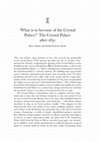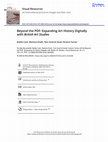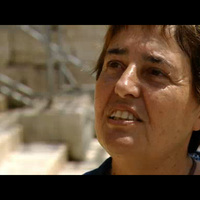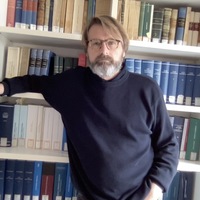Books by Sarah Victoria Turner

Making New Worlds: Li Yuan-chia & Friends is the first book to document the extraordinary activit... more Making New Worlds: Li Yuan-chia & Friends is the first book to document the extraordinary activity at the LYC Museum & Art Gallery in Banks, Cumbria between 1972 and 1983. The LYC was singleminded effort of the artist Li Yuan-chia, who moved to the rural North of England by way of London, Bologna, Taipei and Guangxi, China. At the LYC, Li organised exhibitions, published books, exhibited archealogical artefacts, arranged workshops and welcomed an array of visitors from local and international artists and art workers to nearby residents and travellers, many of whom became friends.
In this book, which accompanies an exhibition of the same name at Kettle's Yard, the curators Hammad Nasar, Amy Tobin and Sarah Victoria Turner, establish Li's work at the LYC as a form of worldmaking, connecting his cosmic conceptual art practice, to his interest in participation and friendship as well as his engagement with nature and the landscape. Nasar, Tobin and Turner's account is accompanied by nine short texts – by Elizabeth Fisher, Ysanne Holt, Annie Jael Kwan, Lesley Ma, Gustavo Grandal Montero, Luke Roberts, Nick Sawyer & Harriet Aspin, Nicola Simpson and Diana Yeh – that trace the diverse threads and ramifications of Li's practice historically and in the present. Richly illustrated, Making New Worlds offers a provocative new way of thinking the history of British art in the twentieth century.

The period from the 1870s to the 1920s was marked by an interplay between nationalisms and intern... more The period from the 1870s to the 1920s was marked by an interplay between nationalisms and internationalisms, culminating in the First World War, on the one hand, and the creation of the League of Nations, on the other. The arts were central to this debate, contributing both to the creation of national traditions and to the emergence of ideas, objects and networks that forged connections between nations or that enabled internationalists to imagine a different world order altogether. The essays presented here explore the ways in which the arts operated internationally during this crucial period of nation-making, and how they helped to challenge national conceptions of citizenship, society, homeland and native tongue. The collection arises from the AHRC-funded research network Internationalism and Cultural Exchange, 1870-1920 (ICE; 2009-2014) and its enquiry into the histories of cultural internationalism and their historiographical implications. This collection has been edited by mem...
Digital Publications by Sarah Victoria Turner

The Royal Academy Summer Exhibition: A Chronicle, 1769–2018 was produced and published by the Pau... more The Royal Academy Summer Exhibition: A Chronicle, 1769–2018 was produced and published by the Paul Mellon Centre. The RA Chronicle is a digital publication that explores the history of the Summer Exhibition at the Royal Academy of Arts in London. Essays examining key artists, artworks, and events from each individual year’s Exhibition are accompanied by 250 completely digitised and searchable copies of the accompanying Exhibition catalogues. This repository of original research and primary source material is intended to shine new light on British art, its exhibition histories, and its publics, and to encourage further innovative study.
The RA Chronicle was launched on 30 May 2018 to coincide with the 250th anniversary year of the annual exhibition of contemporary art at the Royal Academy, and with the exhibition The Great Spectacle: 250 Years of the Summer Exhibition, which was co-curated by Mark Hallett and Sarah Victoria Turner.
The RA Chronicle, which was conceived by Mark Hallett, has been developed and produced by a team of Paul Mellon Centre staff, working with many partners, including our authors, designers, and reviewers. It is important for us to acknowledge that a publication of this size and complexity is only possible by working collaboratively. The RA Chronicle entries have been edited by three content specialist editors—Mark Hallett, Sarah Victoria Turner, and Jessica Feather—who each took responsibility for different periods of this 250-year history, as well as writing some entries themselves. The whole project was managed and edited by Baillie Card. Tom Scutt managed the digital infrastructure and conceptualisation of the project, from the digitisation of the Exhibition catalogues through to the website’s publication. Maisoon Rehani managed all of the picture research and copyright clearances.
The RA Chronicle was also peer-reviewed by three specialist readers, each of whom took responsibility for a portion of the chronology matching their expertise. We are deeply grateful to these readers for their advice and critical feedback. Most of the entries were subject to double-blind peer review, while the rest underwent either single-blind review or open review, depending on their unique formats and subject matter.
We welcome feedback, and hope you will send thoughts and questions to: feedback@chronicle250.com.
Book Chapters by Sarah Victoria Turner
Rana Begum: Space Light Colour, 2021
Eileen Hogan: Personal Geographies, 2019

'"What is to become of the Crystal Palace?": The Crystal Palace after 1851' in After 1851: The material and visual cultures of the Crystal Palace at Sydenham (Manchester: Manchester University Press, 2017), 2017
Echoing Joseph Paxton's question at the close of the Great Exhibition, 'What is to become of the ... more Echoing Joseph Paxton's question at the close of the Great Exhibition, 'What is to become of the Crystal Palace?', this interdisciplinary essay collection argues that there is considerable potential in studying this unique architectural and art-historical document after 1851, when it was rebuilt in the South London suburb of Sydenham. It brings together research on objects, materials and subjects as diverse as those represented under the glass roof of the Sydenham Palace itself; from the Venus de Milo to Sheffield steel, souvenir 'peep eggs' to war memorials, portrait busts to imperial pageants, tropical plants to cartoons made by artists on the spot, copies of paintings from ancient caves in India to 1950s film. Essays do not simply catalogue and collect this eclectic congregation, but provide new ways for assessing the significance of the Sydenham Crystal Palace for both nineteenth- and twentieth-century studies. The volume will be of particular interest to researchers and students of British cultural history, museum studies, and art history.
Papers by Sarah Victoria Turner

Visual Resources, 2019
British Art Studies, a born-digital, open-access journal, co-published by the Paul Mellon Centre ... more British Art Studies, a born-digital, open-access journal, co-published by the Paul Mellon Centre for Studies in British Art (PMC) and the Yale Center for British Art (YCBA), launched in November 2015. This article documents how and why British Art Studies was established and the ethos that has motivated the editorial team to always think "beyond the PDF" in creating a new digital publication for the field of art history. Drawing on case studies of articles and features published in the first seven issues of British Art Studies, the purpose of this article is to reflect on the creation and development of the journal alongside the broader critical and methodological questions that have guided and shaped our approach to publishing. Co-written by the current editorial and production team, this article explores how establishing and maintaining British Art Studies has enabled us and our authors to join the growing conversation about the intersection and cross-fertilization of art-historical research with digital tools and technologies.
After 1851, 2017
This introductory chapter explores and establishes the Sydenham Crystal Palace in relation to exi... more This introductory chapter explores and establishes the Sydenham Crystal Palace in relation to existing scholarship on the Great Exhibition of 1851. The Sydenham Palace combined education, entertainment and commerce, and spans both nineteenth and twentieth centuries. We resituate it as an important location within the London art world and establish the broader connections it had with rival ventures such as the South Kensington Museum and the numerous international exhibitions in the period. We set out the new possibilities for the analysis of both nineteenth- and twentieth-century visual and material cultures opened up by this unique venue, problematising the periodisation of art works and attitudes into discretely ‘Victorian’ and ‘Edwardian’ categories.
British Art Studies, 2016
session 1 | 11 am-12:30 pm Imperial Britishness chair Martina Droth, Yale Center for British Art ... more session 1 | 11 am-12:30 pm Imperial Britishness chair Martina Droth, Yale Center for British Art martina droth is Deputy Director of Research and Curator of Sculpture at the Yale Center for British Art, and co-editor of British Art Studies, an open-access online journal jointly published by Center and the Paul Mellon Centre for Studies in British Art. Her work as an art historian and curator focuses on sculpture and questions about interdisciplinary approaches to practice, materials, and modes of display, with a particular emphasis on British sculpture of the nineteenth and twentieth centuries. Recent curatorial projects include Yinka Shonibare MBE (RA)
British Art Studies, 2015
British Art Studies, 2015











Uploads
Books by Sarah Victoria Turner
In this book, which accompanies an exhibition of the same name at Kettle's Yard, the curators Hammad Nasar, Amy Tobin and Sarah Victoria Turner, establish Li's work at the LYC as a form of worldmaking, connecting his cosmic conceptual art practice, to his interest in participation and friendship as well as his engagement with nature and the landscape. Nasar, Tobin and Turner's account is accompanied by nine short texts – by Elizabeth Fisher, Ysanne Holt, Annie Jael Kwan, Lesley Ma, Gustavo Grandal Montero, Luke Roberts, Nick Sawyer & Harriet Aspin, Nicola Simpson and Diana Yeh – that trace the diverse threads and ramifications of Li's practice historically and in the present. Richly illustrated, Making New Worlds offers a provocative new way of thinking the history of British art in the twentieth century.
Digital Publications by Sarah Victoria Turner
The RA Chronicle was launched on 30 May 2018 to coincide with the 250th anniversary year of the annual exhibition of contemporary art at the Royal Academy, and with the exhibition The Great Spectacle: 250 Years of the Summer Exhibition, which was co-curated by Mark Hallett and Sarah Victoria Turner.
The RA Chronicle, which was conceived by Mark Hallett, has been developed and produced by a team of Paul Mellon Centre staff, working with many partners, including our authors, designers, and reviewers. It is important for us to acknowledge that a publication of this size and complexity is only possible by working collaboratively. The RA Chronicle entries have been edited by three content specialist editors—Mark Hallett, Sarah Victoria Turner, and Jessica Feather—who each took responsibility for different periods of this 250-year history, as well as writing some entries themselves. The whole project was managed and edited by Baillie Card. Tom Scutt managed the digital infrastructure and conceptualisation of the project, from the digitisation of the Exhibition catalogues through to the website’s publication. Maisoon Rehani managed all of the picture research and copyright clearances.
The RA Chronicle was also peer-reviewed by three specialist readers, each of whom took responsibility for a portion of the chronology matching their expertise. We are deeply grateful to these readers for their advice and critical feedback. Most of the entries were subject to double-blind peer review, while the rest underwent either single-blind review or open review, depending on their unique formats and subject matter.
We welcome feedback, and hope you will send thoughts and questions to: feedback@chronicle250.com.
Book Chapters by Sarah Victoria Turner
Papers by Sarah Victoria Turner
In this book, which accompanies an exhibition of the same name at Kettle's Yard, the curators Hammad Nasar, Amy Tobin and Sarah Victoria Turner, establish Li's work at the LYC as a form of worldmaking, connecting his cosmic conceptual art practice, to his interest in participation and friendship as well as his engagement with nature and the landscape. Nasar, Tobin and Turner's account is accompanied by nine short texts – by Elizabeth Fisher, Ysanne Holt, Annie Jael Kwan, Lesley Ma, Gustavo Grandal Montero, Luke Roberts, Nick Sawyer & Harriet Aspin, Nicola Simpson and Diana Yeh – that trace the diverse threads and ramifications of Li's practice historically and in the present. Richly illustrated, Making New Worlds offers a provocative new way of thinking the history of British art in the twentieth century.
The RA Chronicle was launched on 30 May 2018 to coincide with the 250th anniversary year of the annual exhibition of contemporary art at the Royal Academy, and with the exhibition The Great Spectacle: 250 Years of the Summer Exhibition, which was co-curated by Mark Hallett and Sarah Victoria Turner.
The RA Chronicle, which was conceived by Mark Hallett, has been developed and produced by a team of Paul Mellon Centre staff, working with many partners, including our authors, designers, and reviewers. It is important for us to acknowledge that a publication of this size and complexity is only possible by working collaboratively. The RA Chronicle entries have been edited by three content specialist editors—Mark Hallett, Sarah Victoria Turner, and Jessica Feather—who each took responsibility for different periods of this 250-year history, as well as writing some entries themselves. The whole project was managed and edited by Baillie Card. Tom Scutt managed the digital infrastructure and conceptualisation of the project, from the digitisation of the Exhibition catalogues through to the website’s publication. Maisoon Rehani managed all of the picture research and copyright clearances.
The RA Chronicle was also peer-reviewed by three specialist readers, each of whom took responsibility for a portion of the chronology matching their expertise. We are deeply grateful to these readers for their advice and critical feedback. Most of the entries were subject to double-blind peer review, while the rest underwent either single-blind review or open review, depending on their unique formats and subject matter.
We welcome feedback, and hope you will send thoughts and questions to: feedback@chronicle250.com.
With essays by Julie Codell, Jason Edwards, Sarah V. Turner, Adrianne Rubin, Dana Garvey, Imogen Hart, Colette Crossman, Lene Østermark-Johansen, Jane Hawkes, Anthony Burton, and Amy Von Lintel
Attached is the booklet of an exhibition 'Pioneering Spirit: Maud MacCarthy: Mysticism, Music and Modernity', co-written with James Mansell, Christopher Scheer and Rachel Cowgill. The exhibition was held at the Borthwick Institute for Archives at the University of York (7 Feb-9 May 2014). A full digital version of the exhibition is available here: http://hoaportal.york.ac.uk/hoaportal/pioneering-spirit.jsp
The large plaster relief Wrestlers was made in London by the French artist Henri Gaudier-Brzeska (1891–1915) at a time when he was forging a reputation as one of the most radical and innovative sculptors of his generation. Gaudier-Brzeska was killed fighting in the First World War, and his achievements slipped from view in subsequent decades. In the mid-1960s, however, curator Jim Ede had the relief cast in an edition of nine to help make Gaudier-Brzeska’s work better known, and he gave a cast to Tate.
This project explores the circumstances of the making of the relief and the posthumous cast. Drawing on material in the Tate Archive and early twentieth-century sports periodicals, it includes previously unexamined material about Gaudier-Brzeska’s interest in wrestling and asks new questions about representations of sport and physicality in modern art and poetry at the beginning of the twentieth century.
Published by Tate in July 2013, the project is authored by Dr Sarah Victoria Turner (University of York) and includes a commentary and poems by the poet and wrestler S.J. Fowler.
Broadcast on Utah Public Radio, 22 September 2014
This panel seeks presentations and provocations exploring issues relating to the process of creating, collaborating on, publishing, and using 3D visualizations of art works, cultural heritage objects, and architectural spaces. It is chaired by members of the editorial team of British Art Studies (BAS), an online-only peer-reviewed journal that publishes new research on art and architecture. Approaching these issues from the perspective of art history, digital humanities, and cultural heritage, this panel will explore best practices in a growing area of digital art historical research from a range of perspectives.
See CAA's Call for Participation for further details. Proposals must include the following:
Completed session participation proposal form (located in the CAA brochure).
Make sure your name appears EXACTLY as you would like it listed in the conference program and conference website.
Make sure your affliation appears as the offcial, recognized name of your institution (you may not list multiple affiliations).
Make sure to include an active CAA Member ID (all participants must be current members through 24 February 2018; inactive or lapsed members will be pulled from participation on August 28, 2017).
Paper/project abstract: maximum 250 words, in the form of a single paragraph. Make sure your title and abstract appear EXACTLY as you would like them published in the conference program, Abstracts 2018, and the CAA website.
Email or letter explaining your interest in the session, expertise in the topic, and availability during the conference.
A shortened CV.
(Optional) Documentation of work when appropriate, especially for sessions in which artists might discuss their own practice.
A copy of all of the above documentation should be sent to each chair, listed above.
Loughborough University, UK. 6th to 8th April 2017
CALL FOR PROPOSALS: Sculpture in Motion
Sculpture is generally static. It tends to be thought of as solid, inert, and physically grounded. These qualities are deeply associated with some of its most traditional functions – to commemorate, memorialise, and provide permanent public symbols. But throughout its history, sculpture’s immobility has been held in tension with the fantasy of its potential motion and animation. This tension plays out in the dualities of its association with life and death. The potential of the statue coming to life, as in the Pygmalion myth, has been a constant reference point for sculpture and how it is written about.
This interdisciplinary session seeks to examine the various ways in which sculpture has been put in motion, literally or metaphorically, and to consider what drives this desire to animate sculpture. Areas of possible investigation include the devices and artistic strategies that induce motion or an illusion of life – for example, turning statues on rotating pedestals; viewing statues by candlelight; the tinting and colouring of sculpture to create life-like effects; sophisticated technologies and mechanical devices such as animatronics, automata, and kinetics; the ‘living statue’ and the tableau vivant; bringing sculpture to life in text; the suggestion of movement in photographs of sculpture; the appearance of sculpture in film. Proposals may address any period or area of sculpture, and can present case-studies or broader reflections.
Convenors: Martina Droth, Yale Center for British Art (martina.droth@yale.edu) and Sarah Victoria Turner, Paul Mellon Centre for Studies in British Art (svturner@paul-mellon-centre.ac.uk)
For details about the conference see:
http://aah.org.uk/annual-conference/sessions2017